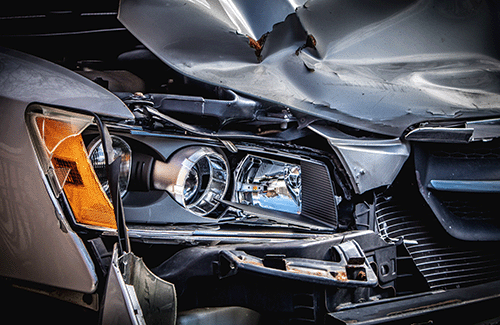 When an accident occurs, it is not always easy to determine the cause or what was happening in each vehicle involved in the crash. An Accident Reconstruction Expert may rely on data from Event Data Recorders or Electronic Data Recorders (EDRs) to draw conclusions. Often referred to as a ‘black box’, EDRs are devices used to record information in most passenger vehicles before, during, and after an accident. They were initially used to record airbag deployment in some vehicle models in the 1970s but have since become more sophisticated and widespread. According to the National Highway Traffic Safety Administration (NHTSA), 99.6% of vehicles manufactured today are equipped with the device. Thanks to the standardization of the information recorded by EDRs, the device es can capture data such as the vehicle's speed, brakes application, airbag deployment, driver and passenger seat belt engagement, engine rpm, and the force generated by the impact, etc.
When an accident occurs, it is not always easy to determine the cause or what was happening in each vehicle involved in the crash. An Accident Reconstruction Expert may rely on data from Event Data Recorders or Electronic Data Recorders (EDRs) to draw conclusions. Often referred to as a ‘black box’, EDRs are devices used to record information in most passenger vehicles before, during, and after an accident. They were initially used to record airbag deployment in some vehicle models in the 1970s but have since become more sophisticated and widespread. According to the National Highway Traffic Safety Administration (NHTSA), 99.6% of vehicles manufactured today are equipped with the device. Thanks to the standardization of the information recorded by EDRs, the device es can capture data such as the vehicle's speed, brakes application, airbag deployment, driver and passenger seat belt engagement, engine rpm, and the force generated by the impact, etc.
Although technological advancements and the NHTSA's efforts to standardize EDRs have broadened the device's capabilities in recording information, there are instances where the crash data is unavailable. For example, if the force from the impact is not significant enough, the device sometimes does not record any crash data. In other cases, the vehicle might be an older model that either does not have an EDR or has one with limited crash data recording capabilities. In these instances, accident reconstruction experts must rely solely on alternative methods to determine the cause of the accident.
Accident Reconstruction Techniques
Evidence on the Road
Tire marks and debris from damaged vehicles are just some of the evidence that can be used in accident reconstruction when EDRs do not or cannot record relevant crash data. For example, the length of the skid marks and the resting position of the vehicle can be analyzed to assess the pre and post-impact velocity of the car as well as driver actions before and during the collision event. An Accident Reconstruction Expert depends on a complex equation of factors to make these calculations, including the type of tire mark, the kind of surface and related friction, and the specific model of vehicle. This information can be utilized in the calculation of pre-impact speeds of colliding vehicles.
Vehicle Damage Patterns
The location, type, and severity of the damage sustained to the vehicles involved in the crash is physical evidence that a reconstructionist can use in their analysis. Damage to the passenger side of the vehicle, often resulting from what is colloquially known as being “t-boned”, in some instances points to the contribution of specific drivers to a collision. Context is also important in assessing vehicle damage, in cases where a car has been “t-boned” it is possible that one of the drivers missed a stop sign, ran a red light at an intersection or pulled out of a driveway without exercising caution.
A significantly damaged car may indicate that the other vehicle was traveling at high speeds at the time of the crash, while minor damage may be indicative of the vehicle traveling at or below the speed limit. Commonly referred to as Crush or Energy Analysis, a calculation is performed to determine the amount of energy needed to cause the level of damage seen on the vehicle. Measurements for this equation are taken by comparing the damaged vehicle to one in an undamaged form, while also factoring in the materials the vehicle is constructed with.
Seatbelts
A seat belt inspection can also help determine usage and force generated by the impact when EDRs are not in play. Experts can use the location and severity of physical evidence found on the seat belt to calculate the force if it was in use at the time of the accident. Seat belts are usually made from nylon or flexible webbing. Therefore, in an accident where significant force is applied, the belt may have signs of being stretched if worn. This stretching creates a rigid area in the material near the buckle that can be distinguished from everyday wear and tear. Reconstruction experts can use stretching or tearing evident in the belt to calculate the average impact force on the driver. It should be noted that the type of collision, whether a rollover, frontal, or rear end, varies and therefore will result in different types of stress or load on the seatbelt and its mechanisms. Whether the belt shows signs of stretching is also heavily dependent on the severity of the collision.
Injuries
Injuries sustained in an accident may help paint a picture of what occurred. Injuries to the driver and passenger may differ based on the location of the damage to the vehicle and the direction of the force applied.
Injuries can also help reveal other key factors such as whether the occupants were wearing seat belts. For example, injuries to the torso can be indicative of contact with the steering wheel or vehicle dashboard which could suggest that the driver was not wearing a seat belt at the time of the accident.
Injury patterns are of great concern in collisions involving pedestrians and/or motorcycles. Injuries can be examined in order to help determine the manner of collision, impact and departure angle with the colliding body, and often whether or not the presumed position in the roadway is accurate.
Witnesses
A witness account of the accident may shed light on the blameworthy individual. Witnesses sometimes present a more accurate view since shock, limited perspective, and other factors may distort the driver’s account of the incident. However, experts prefer to rely on physical evidence. Due to common human error while providing their statements, an unreliable witness may provide varying accounts of what they perceive to have happened. Where human witnesses prove unreliable, traffic cameras and other surrounding devices with video recording capabilities such as front-door ring cameras may help fill in the blanks. Often, this type of data is subject to deletion due simply to the passage of time, reiterating the importance of getting reconstructionists involved early.
When to contact the Accident Reconstruction Expert Witnesses at ESI
When an accident occurs, it is crucial that the evidence at the scene and the vehicles involved be photographed and preserved as soon as possible. While an EDR download can provide much useful data, it doesn't always illustrate the exact chain of events that took place. Attorneys should practice reaching out to an accident reconstructionist as soon as they are retained for an initial consultation. The longer the time between an accident and investigation, the more likely it is for the evidence to deteriorate. Capitalize on the accident reconstruction expert witnesses’ impact on your next case by contacting us early.


